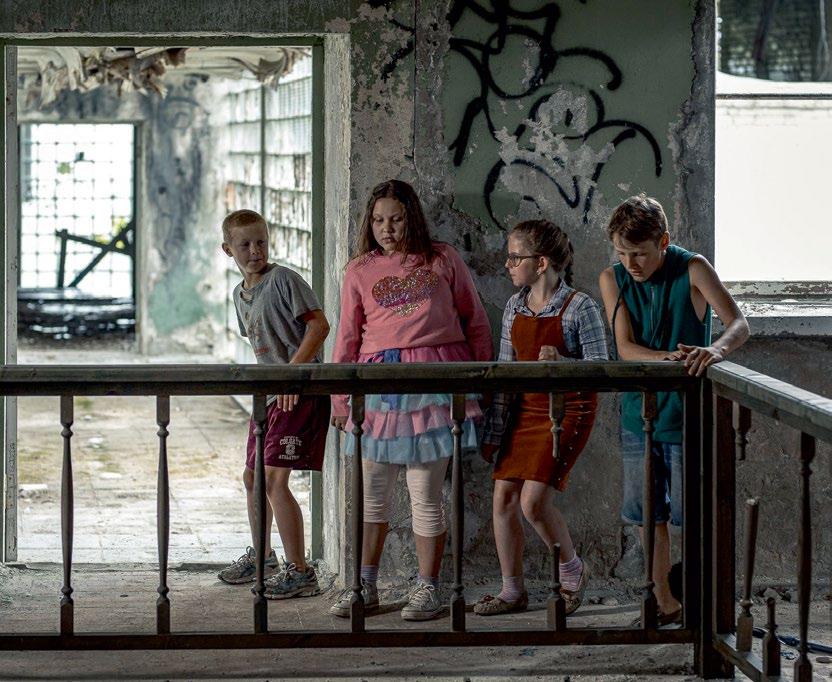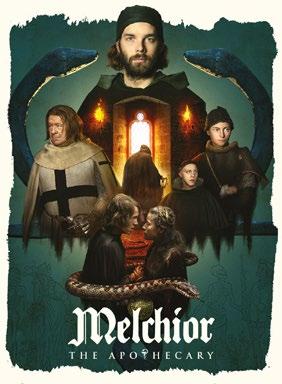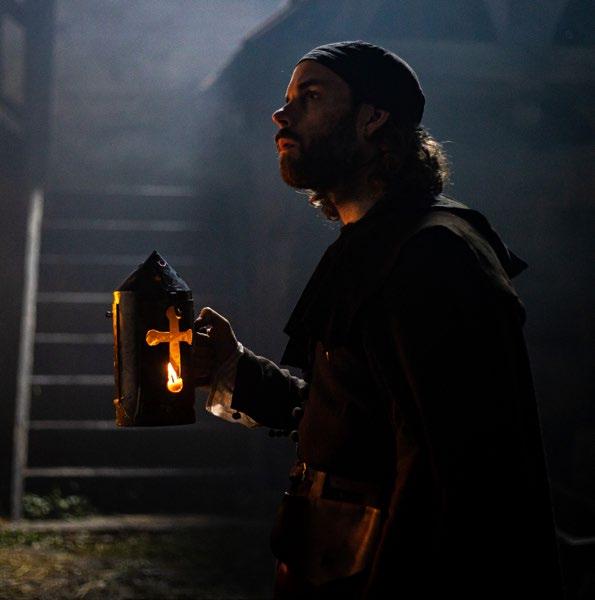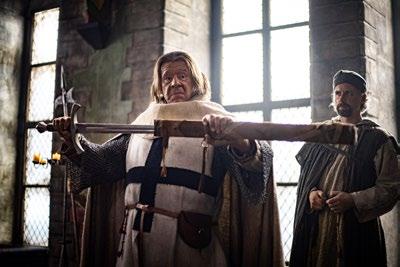
9 minute read
REVIEW The Sleeping Beast

Evil in Shorts
The children-centred adventure drama The Sleeping Beast, directed by Jaak Kilmi, turned out to be a captivating surprise, giving me some anxiety and making me fight back the tears.
With serious themes, the film breaks down barriers between dramas targeted at adult audiences and children’s films. The Sleeping Beast reveals the tension, feelings of guilt, as well as complicated moral dilemmas that threaten to permanently rewrite the protagonists’ coming of age stories.
Director Jaak Kilmi has succeeded in telling the story with the help of young actors, and their improvisational performance leaves a true-to-life impression. Thanks to the diverse characters, the protagonists form a very natural and colourful crowd, where every member has the chance to excel. However, when the story develops, the growing pains of the children start to unwrap: Loore has to take care of her sister, Siim is afraid of his father’s aggressiveness. One does not expect the gravity of the situation at the beginning of the film, where the children playing under the sun’s golden rays gives the impression of an entirely different atmosphere. The children’s gang led by Kristjan conquers the endless greenery, their idyllic playground. Based on their childish fairy tale like logic, they create adventures on the fly.
Whereas the film starts by observing the joys of childhood with relaxed ease, the story subtly develops into increasingly dark and
Ink Big!
The critics have done their job
UNA MARTA SOMS KIMI REIKO PILIPENKO LAURA VAHTRE REBEKA KASK NILS JAAGUP ENGLAND
A FILM BY JAAK KILMI
EVERYTHING IS FINE.
AS LONG AS YOU DON’T TELL ANYONE
NILS JAAGUP ENGLAND LAURA VAHTRE REBEKA KASK KIMI REIKO PILIPENKO UNA MARTA SOMS MIRJA & MIRJE TOOMSALU EVELIN VÕIGEMAST ANTI KOBIN ESTER KUNTU JAANIKA ARUM JUULI LILL REIMO SAGOR ANDRES LEPIK SCREENWRITER AIDI VALLIK CINEMATOGRAPHER ELEN LOTMAN, ESC PRODUCTION DESIGNER GETTER VAHAR COSTUME DESIGNER JAANUS VAHTRA MAKE-UP DESIGNER MERLIT VELDI EDITOR ANDRIS GRANTS SOUND DESIGNER MATĪSS KRIŠJĀNIS COMPOSER KĀRLIS AUZĀNS CO-PRODUCERS DOMINIKS JARMAKOVIČS & ROBERTS VINOVSKIS PRODUCED BY EVELIN PENTTILÄ DIRECTOR JAAK KILMI
The Sleeping Beast By Ralf Sauter First published in Postimees
Aidi Vallik detangles step by step the heartless behavioural pattern of the children, which develops into an unexpected rage. A convincing tension is formed among the children where Kristjan, who worries about Elmar in need of help, reminds one of Ralph in the novel “Lord of the Flies”. The film with its conflicts raises valuable questions about the evil characteristics in children, magnified by the parents’ methods of upbringing. The adults communicate with children indifferently, accusingly, even disgustfully.
The delicate camerawork, with a touch of nostalgia, by Elen Lotman reflects the curious yet frightened world view of children – this is well expressed by the shaken camera when adults come in sight; they are observed from the distance and from the children’s perspective. Such style conveys the difficult truth – the young protagonists see their parents as people whom they are afraid of rather than who can be trusted. Surprisingly, the warmest and most human light is saved for Elmar, whom the villagers consider to be a pervert. The darkly developed storyline of The Sleeping Beast plays well with the industrial building with a grey stone facade – the place the children use as their playground separated from the adult world. On the Big The scenes filmed in the old radio station building lend the film a slightly uncanny atmosphere, since the decayed building hosts a shabby piano that Kristjan toys with for tense dimensions. The children, full of curiosity, go to Screen a moment. This piano seems to express one of the leitmotifs of the play in a deserted industrial film: what is left behind by adults area with prohibited access. will be picked up by children. There they encounter an old The Sleeping Beast is an intelguard Elmar (Andres Lepik) who ligent and sincere film where the is coaxed into a trap. This way, the evil is not presented without reachildren perform an imaginary son – the film discreetly tackles the fairy tale where the monster stink- dark corners of childhood, while ing of vodka has to be imprisoned, alluding to trauma, violence and yet the consequences turn out to various secrets related to young be unexpected. age that may be recognized by sev-
Even if the adult characters of eral viewers in the audience. This the film remain in the periphery of is a story that requires empathy the story, the viewers can see Eve- from its viewers, exploring the lin Võigemast and Reimo Sagor as wrongdoings of childhood, as well co-stars – their impersonal charac- as the desire to behave in the right ters fixate the issues related to a way without breaking the seemneglectful upbringing. Due to the ingly unshakeable ties of friendindifferent ways fathers mould ship. their sons and mothers their And yet, the uncompromising daughters after their own personal- drama won’t serve as a criticism. ities, the children’s gang in The With this film, Kilmi offers clearSleeping Beast will do something cut material for the daily conversafrightening. And regardless of the tions between children and their fact that a human life will be in dan- parents. Hopefully, there is more ger, what happens must remain a benevolence in most parents than secret. The seriousness of the story in those in The Sleeping Beast. will truly shake those cinemagoers The film turned out to be the most hoping to enjoy a funny entertain- moving and exciting Estonian feaing film about children. The de- ture film that I have seen during tailed screenplay by youth writer the past few years. EF


MURDER MYSTERY

in the Middle Ages
Each year introduces some milestones in Estonian film, but Melchior the Apothecary clearly opens a new era in Estonian cinema.
We have the first franchise movie, although some call the Lotte children’s film series also a franchise, but not really in my opinion. The main reason is that Melchior the Apothecary succeeded in securing its international distribution on Amazon+ before the domestic première. There were already three films produced and the trilogy will be in
Ink Big!
The critics have done their job
cinemas in half a year. I’d say that the producers could already start with the fourth, fifth and even the sixth film, as they have hit the sweet spot, a genre that could be sold in Estonia and in the whole world. Melchior the Apothecary is obviously fine-tuned to hit as large segments of audience as possible, but the result is not a lean commercial “soup” but a shamelessly grandiose genre movie. One could have assumed that director Elmo Nüganen would stay within the limits of historical crime movies, but he moves boldly to the margins of a dark thriller, or even horror. Well, actually it cannot be called either, but the producers were not afraid to add some twists to the film. That in turn, gives the film quite a wide platform. On the one side, providing good entertainment in the evening after a hard day at work, as the sharpest edges are cleverly polished and opens up to the viewer quite easily, but on the other hand it is juicy enough to satisfy even the most demanding
Melchior the Apothecary By Kaspar Viilup First published in ERR


fans of this particular genre. The producers have consciously taken a universal commercial angle, preserving at the same time a necessary uniqueness in order to be distinguished in the crowd. It would have been easy to tell the same story more traditionally, just running around in the Old Town of Tallinn, but director Elmo Nüganen gives the novels by Indrek Hargla a much more grandiose interpretation. Nothing is left unnoticed; each frame is dynamic and in motion. As for production, Melchior the Apothecary is one of the most well elaborated domestic films so far – and the sufficient budget has made it possible to produce a film according to the original ideas. Probably the high technical quality is also the reason why it was easy to break through with the film internationally. The Old Town of Tallinn, that is also cunningly elaborated with the help of the episodes filmed in Kuressaare Castle, looks wonderful, and no doubt there will soon be those intrigued to search and see the filming locations with their own eyes. There are places that one can recognize in Tallinn, but the movie magic works and melts it into Wonderland of Middle Age that does not exist in reality.
It must be mentioned that it was an unpleasant surprise to witness the unnecessary and raw computer graphics solutions in the film, mostly used in long shots depicting the Old Town. Of course, these technical solutions could add something to the atmosphere as a whole, but considering the vividness and vitality of the street, such digital postcards have a rather contrary effect. As a result, the real thriller started to remind me of a promotional commercial, which was definitely not the filmmakers’ aim.
Melchior the Apothecary is based on the books of Melchior by Indrek Hargla. The film takes the familiar elements of the books as starting points, but already it is obvious in the first film that the filmmakers are more intrigued by creating a pseudo historic world
Melchior the Apothecary moves boldly to the margins of a dark thriller, or even horror.
The trilogy takes the viewers to Tallinn in the Middle Ages. instead of one particular mystery story.
That is also the reason why the main protagonist, the apothecary Melchior, a middle-aged family man in Hargla’s novel, is turned into a novice apothecary in his twenties. This, in turn, allows us to follow the development of the young man in the movie. The emphases is rearranged and the filmmakers start to tell a story evolving from one film to another. Considering this, it seems a little bit surprising how limited time the audience is given for getting acquainted with the film characters. Shortly after the beginning titles of the film the protagonist is already told to go and resolve the murder. It indeed gives an energetic start to the movie, but leaves too little time for character development. The personality of the pro-












